Lattice Thermal Conductivity of mGeTe•nSb2Te3 Phase-Change Materials: A First-Principles Study
Abstract
1. Introduction
2. Materials and Methods
3. Results and Discussion
4. Conclusions
Author Contributions
Funding
Conflicts of Interest
References
- Ovshinsky, S.R. Reversible electrical switching phenomena in disordered structures. Phys. Rev. Lett. 1968, 21, 1450. [Google Scholar] [CrossRef]
- Kolobov, A.V.; Fons, P.; Frenkel, A.I.; Ankudinov, A.L.; Tominaga, J.; Uruga, T. Understanding the phase-change mechanism of rewritable optical media. Nat. Mater. 2004, 3, 703. [Google Scholar] [CrossRef] [PubMed]
- Wuttig, M.; Yamada, N. Phase-change materials for rewriteable data storage. Nat. Mater. 2007, 6, 824. [Google Scholar] [CrossRef] [PubMed]
- Simpson, R.; Fons, P.; Kolobov, A.; Fukaya, T.; Krbal, M.; Yagi, T.; Tominaga, J. Interfacial phase-change memory. Nat. Nanotechnol. 2011, 6, 501. [Google Scholar] [CrossRef] [PubMed]
- Sun, Z.; Zhou, J.; Pan, Y.; Song, Z.; Mao, H.-K.; Ahuja, R. Pressure-induced reversible amorphization and an amorphous–amorphous transition in Ge2Sb2Te5 phase-change memory material. Proc. Natl. Acad. Sci. USA 2011, 108, 10410–10414. [Google Scholar] [CrossRef] [PubMed]
- Sun, Z.; Zhou, J.; Mao, H.-K.; Ahuja, R. Peierls distortion mediated reversible phase transition in GeTe under pressure. Proc. Natl. Acad. Sci. USA 2012, 109, 5948–5952. [Google Scholar] [CrossRef] [PubMed]
- Wilfredo, I.H.; Raty, J.Y. Ab initio density functional theory study of the electronic, dynamic, and thermoelectric properties of the crystalline pseudobinary chalcogenide (GeTe)x/(Sb2Te3) (x = 1, 2, 3). Phys. Rev. B 2018, 97, 245205. [Google Scholar]
- Davidow, J.; Gelbstein, Y. A comparison between the mechanical and thermoelectric properties of three highly efficient p-type GeTe-rich compositions: TAGS-80, TAGS-85, and 3% Bi2Te3-doped Ge0.87Pb0.13Te. J. Electron. Mater. 2013, 42, 1542–1549. [Google Scholar] [CrossRef]
- Rosi, F.D.; Dismukes, J.P.; Hockings, E.F. Semiconductor materials for thermoelectric power generation up to 700 C. Electr. Eng. 1960, 79, 450–459. [Google Scholar] [CrossRef]
- Rowe, D.M. (Ed.) CRC Handbook of Thermoelectrics; CRC Press: Boca Raton, FL, USA, 1995. [Google Scholar]
- Petrov, I.I.; Imamov, R.M.; Pinsker, Z.G. Electron-diffraction determination of the structures of Ge2Sb2Te5 and GeSb4Te7. Sov. Phys. Crystallogr. 1968, 13, 339–342. [Google Scholar]
- Kooi, B.; De Hosson, J.T.M. Electron diffraction and high-resolution transmission electron microscopy of the high temperature crystal structures of GexSb2Te3+x (x = 1, 2, 3) phase change material. J. Appl. Phys. 2002, 92, 3584–3590. [Google Scholar] [CrossRef]
- Matsunaga, T.; Yamada, N.; Kubota, Y. Structures of stable and metastable Ge2Sb2Te5, an intermetallic compound in GeTe–Sb2Te3 pseudobinary systems. Acta Crystallorg. B Struct. Sci. 2004, 60, 685–691. [Google Scholar] [CrossRef] [PubMed]
- Yu, X.; Robertson, J. Modeling of switching mechanism in GeSbTe chalcogenide superlattices. Sci. Rep. 2015, 5, 12612. [Google Scholar] [CrossRef] [PubMed]
- Campi, D.; Paulatto, L.; Fugallo, G.; Mauri, F.; Bernasconi, M. First-principles calculation of lattice thermal conductivity in crystalline phase change materials: GeTe, Sb2Te3, and Ge2Sb2Te5. Phys. Rev. B 2017, 95, 024311. [Google Scholar] [CrossRef]
- Mukhopadhyay, S.; Sun, J.; Subedi, A.; Siegrist, T.; Singh, D.J. Competing covalent and ionic bonding in Ge-Sb-Te phase change materials. Sci. Rep. 2016, 6, 25981. [Google Scholar] [CrossRef] [PubMed]
- Mukhopadhyay, S.; Lindsay, L.; Singh, D.J. Optic phonons and anisotropic thermal conductivity in hexagonal Ge2Sb2Te5. Sci. Rep. 2016, 6, 37076. [Google Scholar] [CrossRef] [PubMed]
- Ward, A.; Broido, D. Intrinsic phonon relaxation times from first-principles studies of the thermal conductivities of Si and Ge. Phys. Rev. B 2010, 81, 085205. [Google Scholar] [CrossRef]
- Xie, H.; Hu, M.; Bao, H. Thermal conductivity of silicene from first-principles. Appl. Phys. Lett. 2014, 104, 131906. [Google Scholar] [CrossRef]
- Li, W.; Mingo, N. Thermal conductivity of bulk and nanowire InAs, AlN, and BeO polymorphs from first principles. Appl. Phys. Lett. 2013, 114, 183505. [Google Scholar] [CrossRef]
- Blöchl, P.E. Projector augmented-wave method. Phys. Rev. B 1994, 50, 17953–17979. [Google Scholar] [CrossRef]
- Perdew, J.P.; Wang, Y. Erratum: Accurate and simple analytic representation of the electron-gas correlation energy. Phys. Rev. B 1992, 45, 13244. [Google Scholar] [CrossRef]
- Perdew, J.P.; Burke, K.; Ernzerhof, M. Generalized Gradient Approximation Made Simple. Phys. Rev. Lett. 1996, 77, 3865. [Google Scholar] [CrossRef] [PubMed]
- Hafner, J. Ab-initio simulations of materials using VASP: Density-functional theory and beyond. J. Comput. Chem. 2008, 29, 2044–2078. [Google Scholar] [CrossRef] [PubMed]
- Grimme, S. Semiempirical GGA-type density functional constructed with a long-range dispersion correction. J. Comput. Chem. 2006, 27, 1787–1799. [Google Scholar] [CrossRef] [PubMed]
- Togo, A.; Chaput, L.; Tanaka, I.; Hug, G. First-principles phonon calculations of thermal expansion in Ti3SiC2, Ti3AlC2, and Ti3GeC2. Phys. Rev. B 2010, 81, 174301. [Google Scholar] [CrossRef]
- Li, W.; Carrete, J.; Katcho, N.A.; Mingo, N. ShengBTE: A solver of the Boltzmann transport equation for phonons. Comput. Phys. Commun. 2014, 185, 1747–1758. [Google Scholar] [CrossRef]
- Park, Y.; Lee, J.; Youm, M.; Kim, Y.; Lee, H. Crystal structure and atomic arrangement of the metastable Ge2Sb2Te5 thin films deposited on SiO2∕Si substrates by sputtering method. J. Appl. Phys. 2005, 97, 093506. [Google Scholar] [CrossRef]
- Sun, Z.; Zhou, J.; Ahuja, R. Structure of phase change materials for data storage. Phys. Rev. Lett. 2006, 96, 055507. [Google Scholar] [CrossRef] [PubMed]
- Sun, Z.; Kyrsta, S.; Music, D.; Ahuja, R.; Schneider, J.M. Structure of the Ge–Sb–Te phase-change materials studied by theory and experiment. Solid State Commun. 2007, 143, 240–244. [Google Scholar] [CrossRef]
- Zhou, J.; Sun, Z.; Pan, Y.; Song, Z.; Ahuja, R. Vacancy or not: An insight on the intrinsic vacancies in rocksalt-structured GeSbTe alloys from ab initio calculations. Eur. Phys. Lett. 2011, 95, 27002. [Google Scholar] [CrossRef]
- Siegert, K.; Lange, F.; Sittner, E.; Volker, H.; Schlockermann, C.; Siegrist, T.; Wuttig, M. Impact of vacancy ordering on thermal transport in crystalline phase-change materials. Rep. Prog. Phys. 2014, 78, 013001. [Google Scholar] [CrossRef] [PubMed]
- Berlin, K.; Trampert, A. Phase Stability and Anisotropic Sublimation of Cubic Ge–Sb–Te Alloy Observed by In Situ Transmission Electron Microscopy. J. Phys. Chem. C 2018, 122, 2968–2974. [Google Scholar] [CrossRef]
- He, S.; Zhu, L.; Zhou, J.; Sun, Z. Metastable Stacking-Polymorphism in Ge2Sb2Te5. Inorg. Chem. 2017, 56, 11990–11997. [Google Scholar] [CrossRef] [PubMed]
- Matsunaga, T.; Yamada, N. Structural investigation of GeSb2Te4: A high-speed phase-change material. Phys. Rev. B 2004, 69, 104111. [Google Scholar] [CrossRef]
- Matsunaga, T.; Kojima, R.; Yamada, N.; Kifune, K.; Kubota, Y.; Takata, M. Structural features of Ge1Sb4Te7, an intermetallic compound in the GeTe-Sb2Te3 homologous series. Chem. Mater. 2008, 20, 5750–5755. [Google Scholar] [CrossRef]
- Sa, B.; Zhou, J.; Ahuja, R.; Sun, Z. First-principles investigations of electronic and mechanical properties for stable Ge2Sb2Te5 with van der Waals corrections. Comput. Mater. Sci. 2014, 82, 66–69. [Google Scholar] [CrossRef]
- Venkatasubramanian, R.; Siivola, E.; Colpitts, T.; O’quinn, B. Thin-film thermoelectric devices with high room-temperature figures of merit. Nature 2001, 413, 597. [Google Scholar] [CrossRef] [PubMed]
- Konstantinov, P.; Shelimova, L.; Avilov, E.; Kretova, M.; Zemskov, V. Thermoelectric Properties of nGeTe·mSb2Te3 layered Compounds. Inorg. Mater. 2001, 37, 662–668. [Google Scholar] [CrossRef]
- Shin, S.; Kim, H.K.; Song, J.; Choi, D.J.; Cho, H.H. Phase-dependent thermal conductivity of Ge1Sb4Te7 and N: Ge1Sb4Te7 for phase change memory applications. J. Appl. Phys. 2010, 107, 033518. [Google Scholar] [CrossRef]
- Venkatasubramanian, R. Lattice thermal conductivity reduction and phonon localizationlike behavior in superlattice structures. Phys. Rev. B 2000, 61, 3091. [Google Scholar] [CrossRef]
- Mingo, N. Calculation of Si nanowire thermal conductivity using complete phonon dispersion relations. Phys. Rev. B 2003, 68, 113308. [Google Scholar] [CrossRef]
- Lee, S.-H.; Jung, Y.; Agarwal, R. Highly scalable non-volatile and ultra-low-power phase-change nanowire memory. Nat. Nanotechnol. 2007, 2, 626. [Google Scholar] [CrossRef] [PubMed]
- Li, W.; Lindsay, L.; Broido, D.A.; Stewart, D.A.; Mingo, N. Thermal conductivity of bulk and nanowire Mg2SixSn1-x alloys from first principles. Phys. Rev. B 2012, 86, 174307. [Google Scholar] [CrossRef]
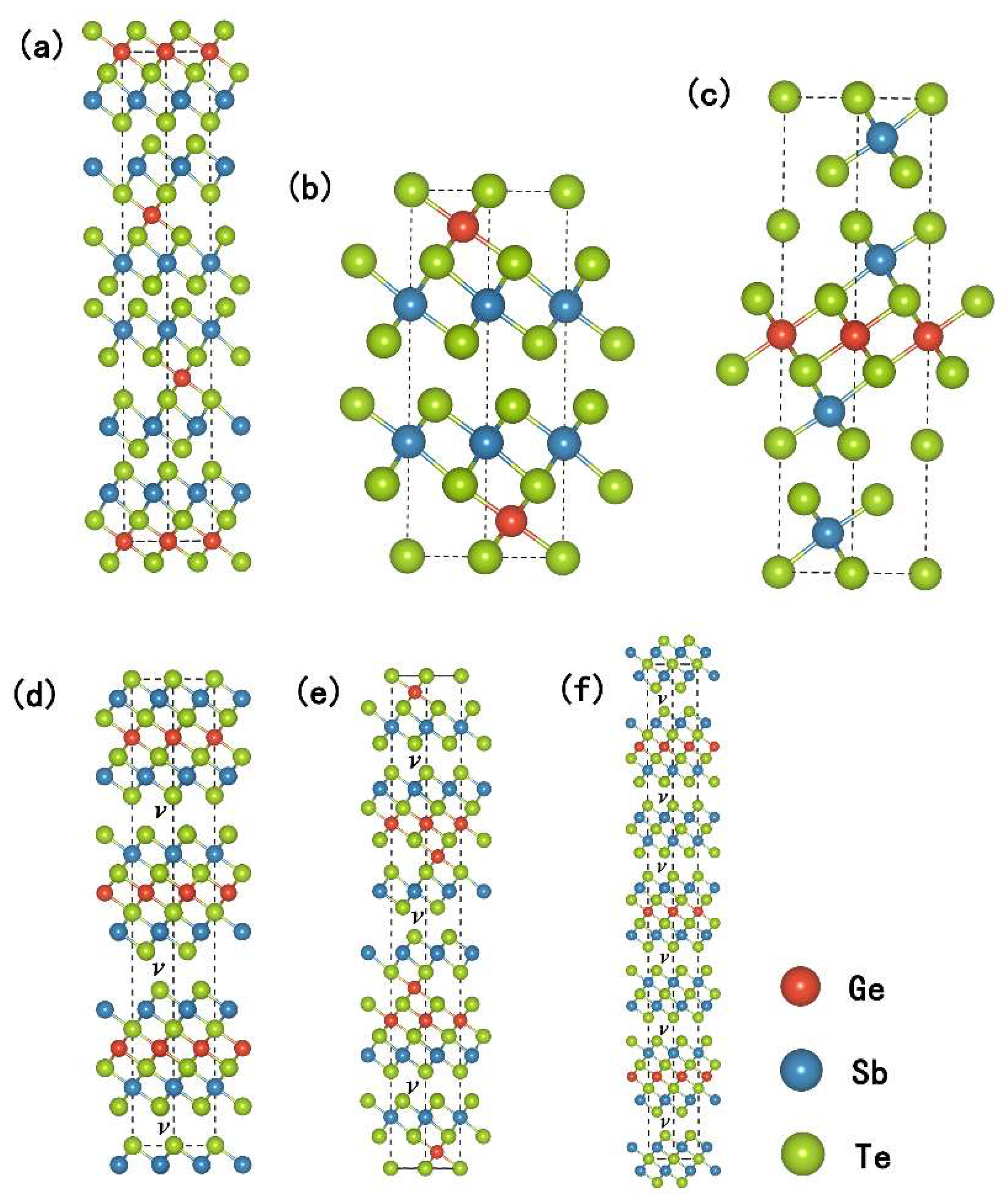
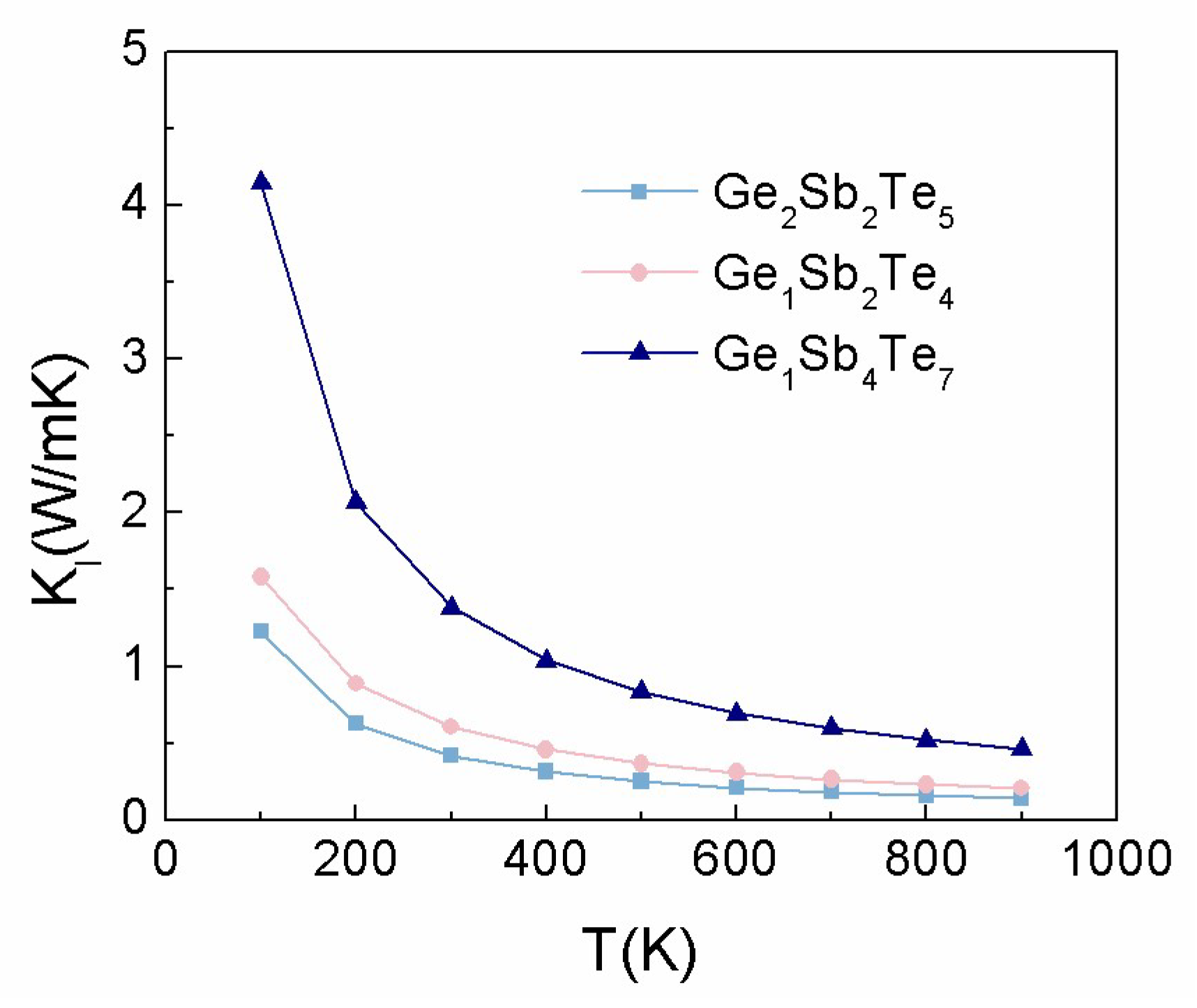
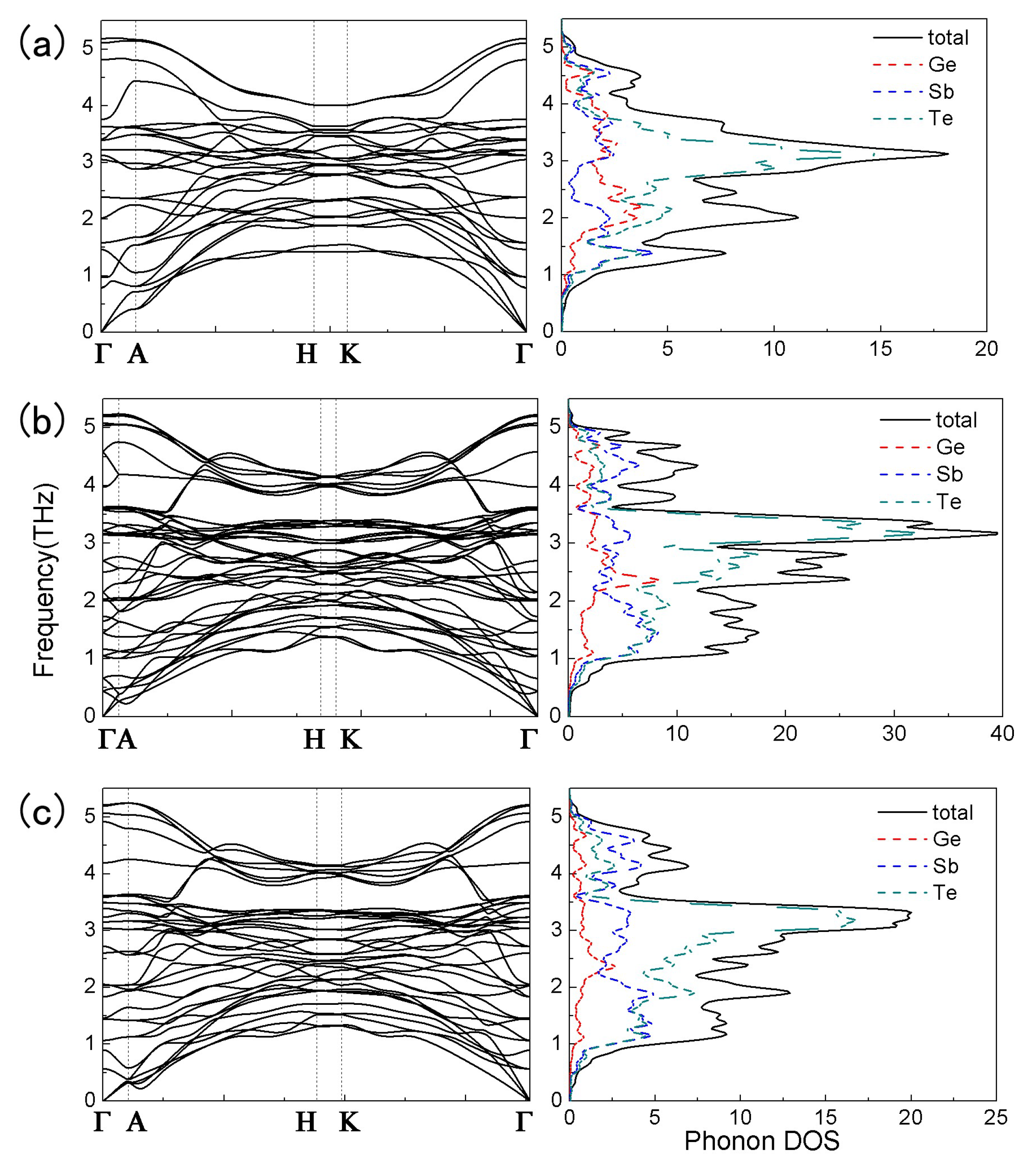
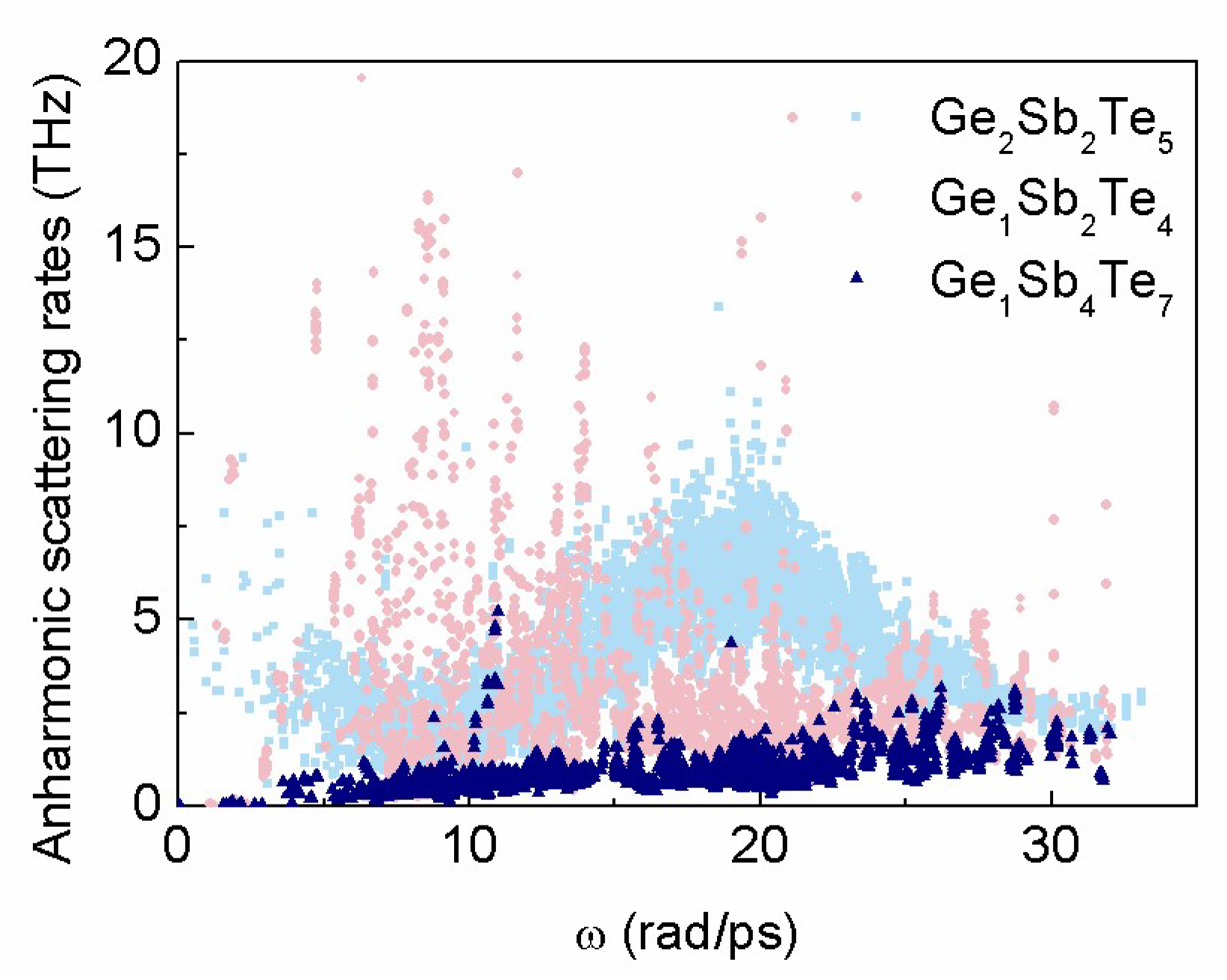
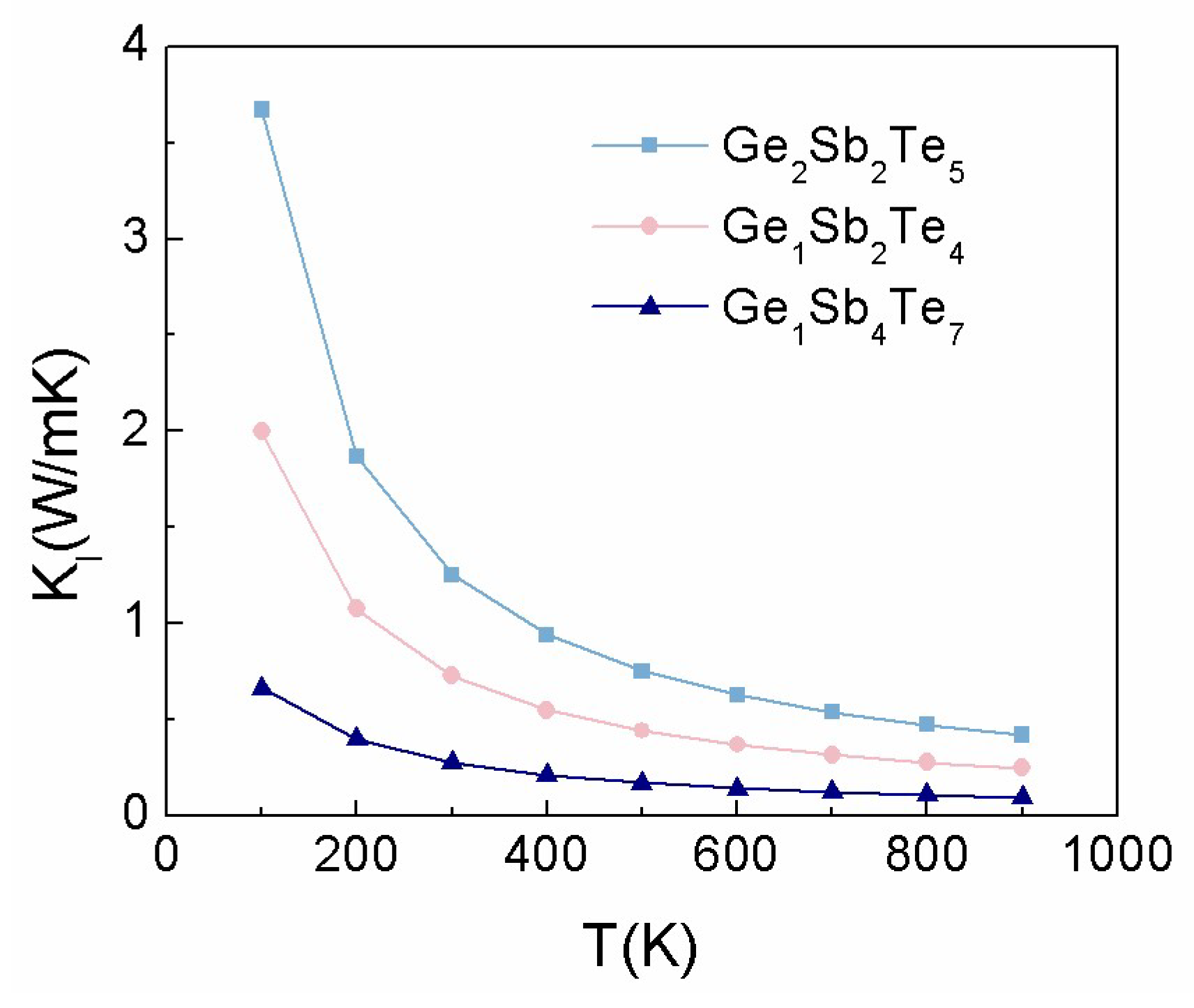
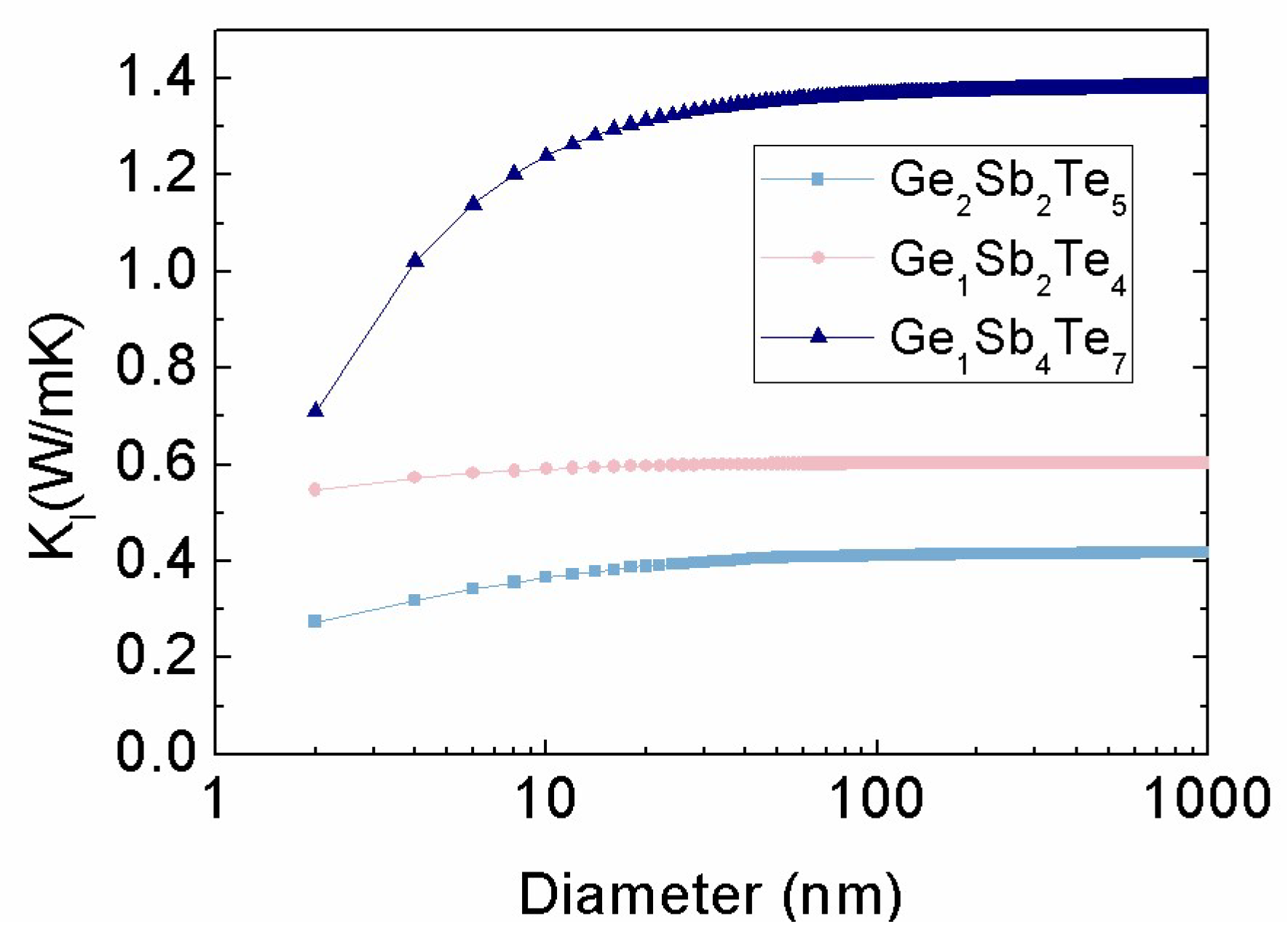

| Compound | Lattice | GGA (Å) | PBE-D2 (Å) | Exp (Å) |
|---|---|---|---|---|
| c-Ge1Sb2Te4 | a | 4.295 | 4.27 1 | |
| c | 43.092 | 13.96 1 | ||
| dTe-v-Te | 4.273 | |||
| c-Ge2Sb2Te5 | a | 4.286 | 4.26 2 | |
| c | 53.580 | 17.40 2 | ||
| dTe-v-Te | 4.286 | |||
| c-Ge1Sb4Te7 | a | 4.304 | ||
| c | 75.595 | |||
| dTe-v-Te | 4.250 | |||
| h-Ge1Sb2Te4 | a | 4.305 | 4.221 | 4.272 1 |
| c | 42.141 | 41.314 | 41.686 1 | |
| dTe-Te | 4.041 | 3.844 | 3.748 1 | |
| h-Ge2Sb2Te5 | a | 4.293 | 4.213 | 4.223 2 |
| c | 17.550 | 17.185 | 17.239 2 | |
| dTe-Te | 4.059 | 3.843 | 3.753 2 | |
| h-Ge1Sb4Te7 | a | 4.317 | 4.230 | 4.236 3 |
| c | 24.474 | 24.084 | 23.761 3 | |
| dTe-Te | 3.984 | 3.829 | 3.691 3 |
© 2019 by the authors. Licensee MDPI, Basel, Switzerland. This article is an open access article distributed under the terms and conditions of the Creative Commons Attribution (CC BY) license (http://creativecommons.org/licenses/by/4.0/).
Share and Cite
Pan, Y.; Li, Z.; Guo, Z. Lattice Thermal Conductivity of mGeTe•nSb2Te3 Phase-Change Materials: A First-Principles Study. Crystals 2019, 9, 136. https://doi.org/10.3390/cryst9030136
Pan Y, Li Z, Guo Z. Lattice Thermal Conductivity of mGeTe•nSb2Te3 Phase-Change Materials: A First-Principles Study. Crystals. 2019; 9(3):136. https://doi.org/10.3390/cryst9030136
Chicago/Turabian StylePan, Yuanchun, Zhen Li, and Zhonglu Guo. 2019. "Lattice Thermal Conductivity of mGeTe•nSb2Te3 Phase-Change Materials: A First-Principles Study" Crystals 9, no. 3: 136. https://doi.org/10.3390/cryst9030136
APA StylePan, Y., Li, Z., & Guo, Z. (2019). Lattice Thermal Conductivity of mGeTe•nSb2Te3 Phase-Change Materials: A First-Principles Study. Crystals, 9(3), 136. https://doi.org/10.3390/cryst9030136





